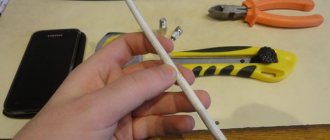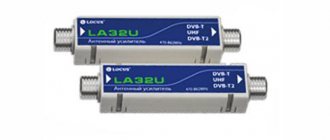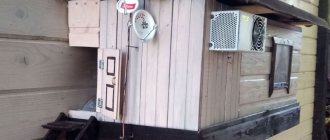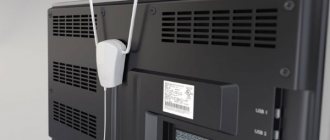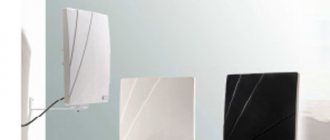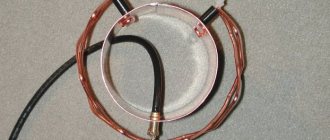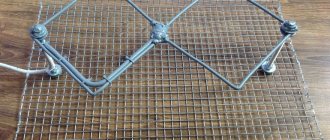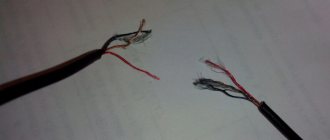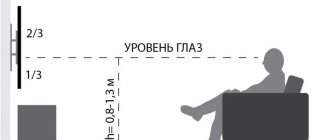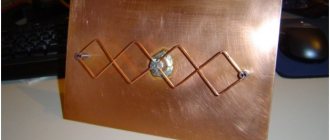Another homemade product for those who are bored at home
I needed a couple of antennas for digital, in places with “not the best reception”... I went shopping (this was before self-isolation - if it’s relatively budget-friendly, then it’s complete G. The more expensive one looks decent, but how it works is questionable.
- if it’s relatively budget-friendly, then it’s complete G. The more expensive one looks decent, but how it works is questionable.
I decided to make something homemade. It was somehow awkward to “twist” an antenna from a piece of cable (although rumor has it it works) - I wanted something simple, but more decent and advanced
In fact, the one I made is not radically more complicated, but somehow more “solid” or something. And the results of its testing were very encouraging, so I decided to sketch out a short description of what and how, in case someone else finds it useful 
... even if my street cats have a “normal” antenna on their house, what can you do without an antenna?!
The wire is not all finished yet, now we’ll assemble something!
In the places described, I previously used home-made broadband log-periodic antennas, probably since the “beginning of perestroika.” They worked well in analog and not only on UHF, but “for some reason, digital was too tough for them.” I didn’t really delve into the essence of the reasons, I removed them and began to think about what to replace them with. Here is one of them, waiting for a place in the trash
They worked well in analog and not only on UHF, but “for some reason, digital was too tough for them.” I didn’t really delve into the essence of the reasons, I removed them and began to think about what to replace them with. Here is one of them, waiting for a place in the trash
Device characteristics
A television antenna is a bipolar device capable of emitting and receiving signals in the meter and decimeter ranges. Modern digital television requires accurate calculation of wavelength indicators, since only in this case is it possible to obtain a high-quality signal.
An analog antenna will pick up any wave, even the weakest one, while a digital one will require a clear, stable signal.
Modern TVs are capable of monitoring the level of digital signals themselves. For other devices you will need to calculate everything yourself.
Currently, television can operate at any frequency and on waves of different lengths. In order for a digital antenna created by yourself to function efficiently, it is necessary to adjust its waves in accordance with the transmitting station.
To do this you will need:
- Calculate the wavelength for each package of television channels;
- Determine the maximum wavelength that has the shape of a sine wave;
- Calculate half the length of the wave cross section.
The calculation is made using the formula: L = 300 / F. Where L denotes the length and F the frequency.
And finally, the most complex antenna for digital TV that you can make yourself
The log-periodic circuit allows you to get maximum gain without additional circuits.
The principle of operation of the design: in the direction of the signal source there are two conductive busbars, on which perpendicular vibrators are installed in strict sequence. Their length and distance between each other are calculated according to a strict algorithm. An error of 2–5% will lead to complete system inoperability. But a properly assembled antenna will receive analog and digital signals with the highest quality.
Note:
This type of antenna requires careful orientation towards the TV tower.
Can be used with a screen that helps strengthen a weak signal.
Selecting a location and connecting
Determining where to install the antenna usually depends on how it is connected. Placement can be indoor or outdoor. It should be understood that the external option involves more convenient signal reception.
- An outdoor antenna is usually mounted on the roof so that there are fewer obstacles in the form of walls and other buildings.
- But we must not forget that the clarity of the signal largely depends on the length of the cable. The larger it is, the lower the quality of transmission.
- An indoor antenna works best if there is a clear signal. Owners of dachas and country houses are looking for compromise options.
Experts recommend measuring signal quality with special instruments that can help eliminate errors in equipment placement.
Assembly principle
The workpiece, selected according to its length, is divided into two equal tubes, which are crimped on one side. The tubes are fixed at a distance of 6-7 cm from each other, and their ends are attached to the textolite blank with clamps. The resulting structure is secured with a rod in a vertical position.
To connect the cable, you need to lay a loop designed for a resistance of 75 ohms. The middle cores of the cable are stripped and twisted with the ends of the tubes flattened, and the braid connection is made using copper wire. The connection of the rest of the loop and the cable going to the output to the television device follows the same principle.
The resulting loop and the remaining length of the cable should be securely fastened to a vertical stand to avoid interference. The required antenna installation height is adjusted locally by monitoring the signal change.
Coaxial cable device
The simplest option for a self-made antenna is considered to be a product made from coaxial cable. Equipment can be manufactured quite quickly and without special training.
This antenna receives channels in the UHF range. In addition to the cable, to assemble the product you will need a piece of plywood or other sheet material to create a platform on which the device will be mounted.
You will also need cutting tools and electrical tape. Next you need to follow the instructions:
- Cut a piece of cable a little more than half a meter long and bend it into a ring without connecting the ends. Secure it like this to the base.
- Use another piece of cable (0.175 m) as a loop and connect.
- At the other end of the cable, install a connector for connecting to the TV.
The antenna is ready to receive the signal, but may be too weak. In this case, you will need to purchase an amplifier unit. You can also complicate the product by wrapping the cable in a figure eight.
Gain for GSM communication
There is no need to improve reception in urban areas. The signal is transmitted well, the towers are densely built. But in remote countryside areas the signal may be of poor quality. This is where reinforcement is required.
Cellular communications are transmitted via ultrashort waves at frequencies of 900 and 1800 MHz. The higher the value, the further the signal can be transmitted. Therefore, outside the city, a frequency calculation of 1800 MHz is required.
Using the calculation formula, the wave is 300/1800 = 166 mm, and the side is 41.5 mm.
Modern devices are not designed to work with an external antenna. You can connect the devices only from the inside, after disassembling the phone. Therefore, it is recommended to use an old cell phone for this purpose.
Figure 8 antenna
Another version of the simplest device for receiving a television signal is a figure-of-eight antenna. The photos of the antenna presented give an idea of why this name was chosen.
The available materials are: a thick cardboard box, a special cable, a tip for connecting to a TV, a soldering iron, electrical tape, foil, glue, cutting tools.
The manufacturing process consists of several stages:
- Cover the bottom of the box with foil so that it serves as a signal reflector.
- Close the box and attach a figure-of-eight cable to the lid.
- From the middle part of the figure eight, bring out two ends to connect the product.
- Connect one end of the conductive cable to the TV using a connector, and run the other from the screen to the central core.
- Connect the ends of the cable to the exposed ends of the figure eight.
The figure-eight antenna is ready for use. It can provide a high-quality digital signal that is not inferior to satellite.
Idea No. 2 – Use wire
Another equally good option that is advisable to use in the village is a homemade antenna made of copper wire with an amplifier.
All you need for production is:
- amplifier (suitable from an old device, for example, a non-working or disassembled antenna);
- two pieces of wire 180 cm each, it is advisable to choose thick and stiff so that the wind does not damage the device;
- a piece of metal (or wood) plate 15*15 cm;
- electric drill with a set of drills (a welding machine is desirable);
- small bolts;
- hammer;
- iron pipe;
- a television cable of suitable length with a plug (sold in radio stores, not expensive, can be removed from a non-working device).
So, to make your own TV antenna from copper wire, you need to complete the following steps:
- We prepare the catcher: we bend the wire into a rhombus so that all sides are exactly 45 cm - these are the optimal dimensions of the receiving part, and the figure must be closed; for this, the ends of the rod must be welded together, or soldered with a powerful soldering iron.
- We fix the wire to the prepared board: drill holes and tighten the bolts for reliable fastening. You need to connect the amplifier immediately. It has two large pads and contacts for connecting a coaxial cable. To large areas, you need to connect different antenna arms in the center using screws. Try to ensure high-quality contact, so it is recommended to clean the surfaces, you can even tin them.
- We connect the cable. Everything is simple here, because... you just need to tighten a couple of screws on the amplifier and insert the plug into the connector.
- We create a mast, for which we use a metal pipe of a suitable height. We dig it in and the homemade antenna for the TV is ready, you can start tuning the channels.
Please note that in the photo examples, both the amplifier, the reflector, and the wire are covered with paint. Painting protects the structure from corrosion and other adverse factors, significantly extending the life of a homemade TV antenna.
Device made from aluminum cans
A fairly popular antenna model is made from simple aluminum drink cans. The containers have a lot of advantages, as they have a sufficient area when unfolded, have good conductivity close to copper, and have a streamlined shape that reduces windage. The main advantage is the absolute availability of the material.
In addition to the aluminum parts, you will need 10 m of high-quality television cable with a durable central core and a continuous double braid. You also need to prepare a wooden hanger, fasteners, electrical tape and a soldering tool. Then, following the instructions, you can begin assembly:
- First, the cable is prepared. It is cut at one end and partially cleared of the insulating coating.
- The inner copper core is then released.
- The opposite end is equipped with a nozzle for connecting to TV.
- The contacts, freed from insulation, are soldered to the banks.
- The cans are fixed in one line on the hanger using electrical tape at a distance of 7.5 cm.
It is better to place an antenna made from cans on a window. It will work especially well if there are no high-rise buildings between it and the station.
Making your own television equipment is a great way to save money and an opportunity to acquire the necessary equipment. You can make your own Wi-Fi antenna, designs for analogue or digital television.
